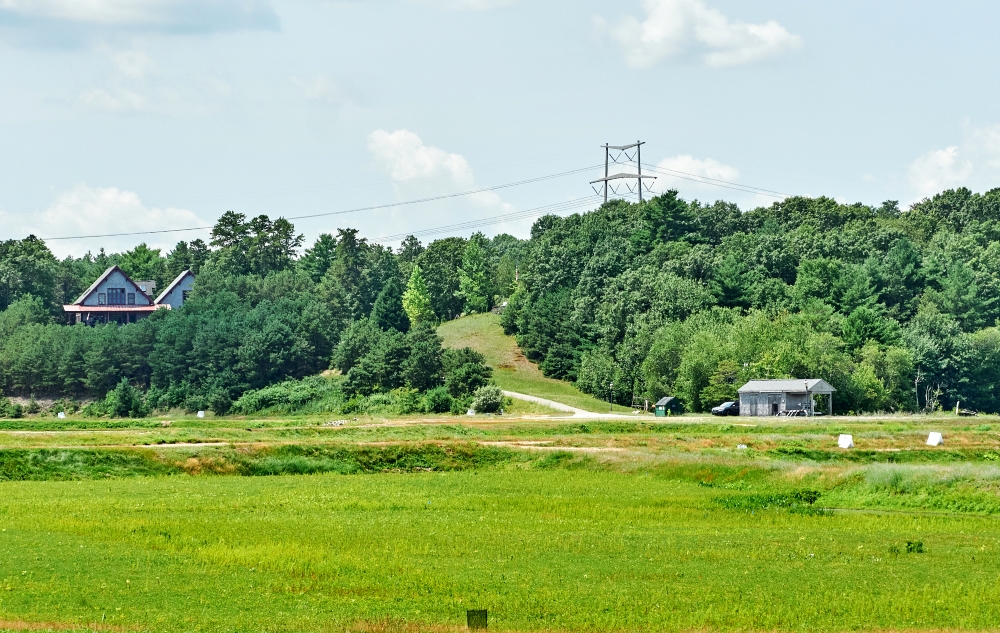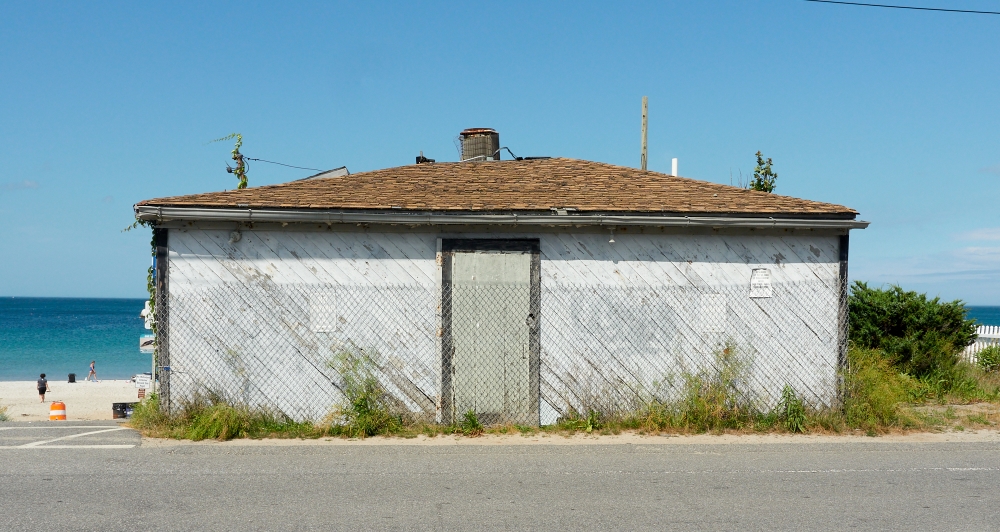A key town committee has given its support to using taxpayers’ money to create more access to White Horse Beach and to former cranberry bogs, as well as for funding affordable housing across the street from the library on South Street.
The Community Preservation Committee Thursday night voted unanimously to recommend buying six properties at White Horse Beach, including the dilapidated building that once housed the Full Sail bar.
The bar had been shuttered for years when it was ravaged by fire in 2016. The town had tried unsuccessfully to buy it to tear it down and offer more public access to White Horse Beach.
“We’ve been trying to get Full Sail for years,” said committee member Betty Cavacco. She is one of several town officials that include David Gould, director of energy and environment, and former Community Preservation Committee chair Bill Keohan, who had unsuccessfully approached the owner of the property, Theodore “Skip” Fucillo, about selling.
The squat, weather worn shack on Taylor Avenue today looks more like a shipwreck than a full sail. But it is on the beachfront.
If Town Meeting approves the recommendation in October, the town would pay the appraised price of $655,000 for the six properties, and allocate another $220,000 to demolish the structure, build a wheelchair-accessible path to the beach, improve the 24-car parking lot with gravel, landscape the parking lot and the beachfront, and possibly provide benches and shade sails like the ones already up at Stephens Field, Gould said.
Select Board member John Mahoney, who is also a member of the preservation committee, said the deal was reached thanks to his Select Board colleague Charlie Bletzer, who he said convinced Fucillo to sell.
“I grew up on White Horse beach as a summer resident,” Bletzer told the Independent. “I still consider it my beach.”
When the rustic bar opened in 1975, an 18-year-old Bletzer worked the door Friday nights.
“It was a great place,” he said.
Bletzer said that in July 2023, he called Fucillo, his onetime boss, who told him he had planned to give the property to his daughter, but she did not want it. Bletzer passed the information on to Gould. He called Fucillo, who agreed to sell.
Bletzer said the town received the signed purchase and sale agreement Thursday. It will pay Fucillo $655,000. The six properties are assessed at $525,000, Gould said. Bletzer credited Mahoney, Gould, and Town Manager Derek Brindisi for helping to make purchase happen.
“It’s not going to be an eyesore anymore,” said Bletzer.
This is not the first time that the Community Preservation Committee has proposed funding the purchase of a White Horse Beach property. The committee previously recommended funding the acquisition and demolition of two cottages on Taylor Avenue and the building of a sand dune in their place, as well as the purchase and demolition of a third cottage. Town Meeting approved both those purchases.
“Public access to the ocean is something we should be striving for,” said Tim Grandy, the committee’s newly elected vice chair.

The committee also voted unanimously to recommend funding a project proposed by the Wildlands Trust and presented by Gould – the purchase of 90 acres from A. D. Makepeace, owner of the Redbrook development in South Plymouth. The parcel is made up of former cranberry bogs at Black Cat Road, adjacent to the headwaters of Town Brook.
The property has been appraised at $1.15 million. Gould has applied for a grant from the state that could cover 90 percent of the purchase price, which would put the cost to the town at $115,000. He said the town could find out as early as next week if it will receive the state money.
Gould explained that 70 acres would be restored to the kind of wetlands that once were there. He said the project would improve water quality for Billington Sea and Town Brook. The other 20 acres would be open space for walking and biking.
Also on Thursday, a recommendation to help fund an affordable housing project proposed by developer Rick Vayo was approved, but it also sparked disagreement among committee members.
Vayo wants to build 24 affordable one-bedroom apartments across the street from the library on South Street, in exchange for a subsidy of $3.6 million for an $8.25 million project. He calculated at a June meeting that rent for each unit would be about $2,300 a month with the taxpayer-funded subsidy, compared with a market rate of $2,800.
Thursday, Cavacco proposed reducing the subsidy to $3.2 million.
Committee member Len Levin opposed the project altogether.
“I believe the value proposition is zero,” Levin said.
“It does give back to the town because people are desperate for housing,” Cavacco replied.
Mahoney, too, opposed funding the project, arguing that the committee was taking on unprecedented debt – about $13 million before the new recommended expenditures. Over the years, the committee has leveraged the approximately $4 million annually it receives from a surcharge on property taxes so that it can support more projects. By law, those projects must support historic preservation, the acquisition of open space, spaces for recreation, and the creation of affordable housing.
“The debt that this committee has carried in the past was never at this level,” Mahoney said. He pointed out that the $655,000 Full Sail purchase, the $220,000 to upgrade the property, and the $115,000 cranberry bog purchases would cost the town $990,000. Adding Vayo’s project would mean the committee could be approving $4.19 million in spending this year. The new projects, if approved by Town Meeting, would bring the total Community Preservation debt to $17 million.
“From a debt perspective, I can’t go any higher,” Mahoney said.
Still, Cavacco argued for moving forward, stressing the need for more reasonably priced housing.
“I’m surprised that you don’t want to increase the debt,” she told Mahoney. People are moving out of Plymouth because they cannot find affordable housing, she said.
In the end, Levin and Mahoney found themselves in the minority, and the committee voted, 6-2, to propose providing $3.2 million to Vayo’s project.
The committee was united in its opposition on another matter – a proposal from Project Gurnet and Bug Lights, a nonprofit, requesting $1.5 million to fund the restoration of Bug Light on the edge of Plymouth Harbor.
“It’s very disappointing for us,” said Scott Day, vice president of the nonprofit.
Community Preservation funds may only be spent on a property if a deed restriction can be placed on it, but that doesn’t seem feasible in this case. Town counsel advised the committee that federal law prevents any encumbrances from being placed on lighthouses without the approval of the Secretary of Homeland Security.
During a site visit with Gould and Brindisi to Gurnet Light last fall to consider whether Plymouth should apply to the federal government to receive that lighthouse, Mahoney said he asked Day if the group would be willing to bid together with Plymouth on the lighthouse, with the understanding that the people of Plymouth could have more access to it if their joint bid was successful.
“We got an emphatic no,” he said.
Day said he does not recall Mahoney asking that question.
At a committee meeting in June, Mahoney reminded Day and Dolly Snow Bicknell, president of the nonprofit, that the group wants money from Plymouth taxpayers for Bug Light, it should significantly increase public access to Gurnet Light, should it be successful in acquiring it. He received no commitment.
“I am confused by his comments,” Snow Bicknell said this week.
Thursday night’s meeting was the committee’s first since Bill Fornaciari resigned as chair, just two weeks after accepting the post. It unanimously elected former fire chief Ed Bradley as the new chair.
Fred Thys can be reached at fred@plymouthindependent.org.

